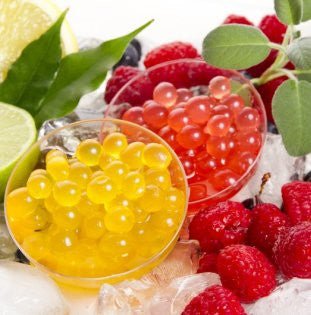Trending searches
Trending searches

Spherification Process
SUBSCRIBE TO OUR BLOG
Promotions, new products, and recipes.
Spherification is the culinary process of shaping a liquid into spheres usually using sodium alginate such as Cape Crystal Brands Sodium Alginate mixed with either calcium chloride or calcium glucate lactate. Upon completion the result appears to resemble caviar. The technique was accidentally discovered by Unilever in the 1950s and brought to the modernist cuisine by the creative team at elBulli under the direction of executive chef Ferran Adrià.
With the alginate mixed with water and a calcium salt, when droplets of liquid such as fruit juice each dropped it tends to form into a small sphere in the calcium solution. Then, during a reaction time of a few seconds to a few minutes, the calcium solution causes the outer layer of each alginated liquid sphere to form a thin, flexible skin. The resulting artificial "caviar" balls are rinsed in water and saved for later use in food or beverages. They are especially colorful when filled with a variety of fruit juices.


|
About the Author Ed is the founder of Cape Crystal Brands, editor of the Beginner’s Guide to Hydrocolloids, and a passionate advocate for making food science accessible to all. Discover premium ingredients, expert resources, and free formulation tools at capecrystalbrands.com/tools. — Ed |
Related Posts

The Complete History of Xanthan Gum: From Accidental Discovery to Global Industry Standard

5 Easy Molecular Gastronomy Recipes Using Sodium Alginate

Aluminum-Free vs Regular Baking Powder: Which Is Best for Gluten-Free Baking?
Enjoyed this post? Subscribe to The Crystal Scoop
Food-science tips, ingredient know-how, and recipes. No spam—unsubscribe anytime.
- Choosing a selection results in a full page refresh.
POLICY PAGES
QUICK LINKS
Guar Gum
Cape Crystal Brands, 18 Bank St., Suite 1, Summit NJ 07901.
- Phone: +1 908-273-5600
- Email: info@capecrystalbrands.com
- Tax ID: 26-2477626000
- FDA Facility Registration # 16980627550
- Kosher Certified: OKosher.org
Country/region
© 2025, Cape Crystal Brands | Sitemap
